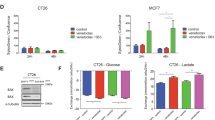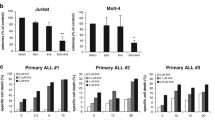Abstract
We recently reported that inhibition of Cyclooxygenase-2 (Cox-2) reduced human B-CLL proliferation and survival. Herein, we investigated the mechanisms whereby small molecule Cox-2 selective inhibitors, SC-58125 (a Celebrex analog) and CAY10404 blunt survival of human B-cell lymphomas and chronic lymphocytic leukemia B-cells. SC-58125 and OSU03012 (a Celebrex analog that lacks Cox-2 inhibitory activity) both decreased intracellular glutathione (GSH) content in malignant human B-cells, as well as in Cox-2 deficient mouse B-cells. This new finding supports Cox-2 independent effects of SC-58125. Interestingly, SC-58125 also significantly increased B-cell reactive oxygen species (ROS) production, suggesting that ROS are a pathway that reduces malignant cell survival. Addition of GSH ethyl ester protected B lymphomas from the increased mitochondrial membrane permeability and reduced survival induced by SC-58125. Moreover, the SC-58125-mediated GSH depletion resulted in elevated steady-state levels of the glutamate cysteine ligase catalytic subunit mRNA and protein. These new findings of increased ROS and diminished GSH levels following SC-58125 exposure support novel mechanisms whereby a Cox-2 selective inhibitor reduces malignant B-cell survival. These observations also support the concept that certain Cox-2 selective inhibitors may have therapeutic value in combination with other drugs to kill malignant B lineage cells.







Similar content being viewed by others
Abbreviations
- Cox-2:
-
Cyclooxygenase-2
- GSH:
-
Glutathione
- ROS:
-
Reactive oxygen species
- GCL:
-
Glutamate cysteine ligase
References
Singh B, Berry JA, Shoher A, Ramakrishnan V, Lucci A (2005) COX-2 overexpression increases motility and invasion of breast cancer cells. Int J Oncol 26:1393–1399
Chen Q, Shinohara N, Abe T, Watanabe T, Nonomura K, Koyanagi T (2004) Significance of COX-2 expression in human renal cell carcinoma cell lines. Int J Cancer 108:825–832
Dubois RN (2000) Review article: cyclooxygenase—a target for colon cancer prevention. Aliment Pharmacol Ther 14(Suppl 1):64–67
Samoha S, Arber N (2005) Cyclooxygenase-2 inhibition prevents colorectal cancer: from the bench to the bed side. Oncology 69(Suppl 1):33–37
Nakao S, Kuwano T, Tsutsumi-Miyahara C, Ueda S, Kimura YN, Hamano S, Sonoda KH, Saijo Y, Nukiwa T, Strieter RM, Ishibashi T, Kuwano M, Ono M (2005) Infiltration of COX-2-expressing macrophages is a prerequisite for IL-1beta-induced neovascularization and tumor growth. J Clin Invest 115:2979–2991
Zhi YH, Liu RS, Song MM, Tian Y, Long J, Tu W, Guo RX (2005) Cyclooxygenase-2 promotes angiogenesis by increasing vascular endothelial growth factor and predicts prognosis in gallbladder carcinoma. World J Gastroenterol 11:3724–3728
Ito H, Duxbury M, Benoit E, Clancy TE, Zinner MJ, Ashley SW, Whang EE (2004) Prostaglandin E2 enhances pancreatic cancer invasiveness through an Ets-1-dependent induction of matrix metalloproteinase-2. Cancer Res 64:7439–7446
Park JH, Kang KH, Kim SH, Lee JH, Cho CM, Kweon YO, Kim SK, Choi YH, Bae HI, Kim MS (2005) Expression of Cyclooxygenase-2 and Bcl-2 in human gastric adenomas. Korean J Intern Med 20:198–204
Charames GS, Bapat B (2006) Cyclooxygenase-2 knockdown by RNA interference in colon cancer. Int J Oncol 28:543–549
Han S, Roman J (2006) COX-2 inhibitors suppress lung cancer cell growth by inducing p21 via COX-2 independent signals. Lung Cancer 51(3):283–296
Palayoor ST, Arayankalayil MJ, Shoaibi A, Coleman CN (2005) Radiation sensitivity of human carcinoma cells transfected with small interfering RNA Targeted against cyclooxygenase-2. Clin Cancer Res 11:6980–6986
Arico S, Pattingre S, Bauvy C, Gane P, Barbat A, Codogno P, Ogier-Denis E (2002) Celecoxib induces apoptosis by inhibiting 3-phosphoinositide-dependent protein kinase-1 activity in the human colon cancer HT-29 cell line. J Biol Chem 277:27613–27621
Johnson AJ, Hsu AL, Lin HP, Song X, Chen CS (2002) The cyclo-oxygenase-2 inhibitor celecoxib perturbs intracellular calcium by inhibiting endoplasmic reticulum Ca2+-ATPases: a plausible link with its anti-tumour effect and cardiovascular risks. Biochem J 366:831–837
Maier TJ, Janssen A, Schmidt R, Geisslinger G, Grosch S (2005) Targeting the beta-catenin/APC pathway: a novel mechanism to explain the cyclooxygenase-2-independent anticarcinogenic effects of celecoxib in human colon carcinoma cells. Faseb J 19:1353–1355
Weber A, Casini A, Heine A, Kuhn D, Supuran CT, Scozzafava A, Klebe G (2004) Unexpected nanomolar inhibition of carbonic anhydrase by COX-2-selective celecoxib: new pharmacological opportunities due to related binding site recognition. J Med Chem 47:550–557
Zhu J, Song X, Lin HP, Young DC, Yan S, Marquez VE, Chen CS (2002) Using cyclooxygenase-2 inhibitors as molecular platforms to develop a new class of apoptosis-inducing agents. J Natl Cancer Inst 94:1745–1757
Phipps RP, Ryan E, Bernstein SH (2004) Inhibition of cyclooxygenase-2: a new targeted therapy for B-cell lymphoma? Leuk Res 28:109–111
Hazar B, Ergin M, Seyrek E, Erdogan S, Tuncer I, Hakverdi S (2004) Cyclooxygenase-2 (Cox-2) expression in lymphomas. Leuk Lymphoma 45:1395–1399
Wun T, McKnight H, Tuscano JM (2004) Increased cyclooxygenase-2 (COX-2): a potential role in the pathogenesis of lymphoma. Leuk Res 28:179–190
Secchiero P, Barbarotto E, Gonelli A, Tiribelli M, Zerbinati C, Celeghini C, Agostinelli C, Pileri SA, Zauli G (2005) Potential pathogenetic implications of cyclooxygenase-2 overexpression in B chronic lymphoid leukemia cells. Am J Pathol 167:1599–1607
Ryan EP, Pollock SJ, Kaur K, Felgar RE, Bernstein SH, Chiorrazi N, Phipps RP (2006) Constitutive and activation-inducible cyclooxygenase-2 expression enhances survival of chronic lymphocytic leukemia B cells. Clin Immunol 120(1):76–90
Armstrong JS, Steinauer KK, Hornung B, Irish JM, Lecane P, Birrell GW, Peehl DM, Knox SJ (2002) Role of glutathione depletion and reactive oxygen species generation in apoptotic signaling in a human B lymphoma cell line. Cell Death Differ 9:252–263
Ferraris AM, Rolfo M, Mangerini R, Gaetani GF (1994) Increased glutathione in chronic lymphocytic leukemia lymphocytes. Am J Hematol 47:237–238
Margalit A, Hauser SD, Zweifel BS, Anderson MA, Isakson PC (1998) Regulation of prostaglandin biosynthesis in vivo by glutathione. Am J Physiol 274:R294–R302
Pompella A, Visvikis A, Paolicchi A, De Tata V, Casini AF (2003) The changing faces of glutathione, a cellular protagonist. Biochem Pharmacol 66:1499–1503
Fedyk ER, Phipps RP (1994) Reactive oxygen species and not lipoxygenase products are required for mouse B-lymphocyte activation and differentiation. Int J Immunopharmacol 16:533–546
Padilla J, Leung E, Phipps RP (2002) Human B lymphocytes and B lymphomas express PPAR-gamma and are killed by PPAR-gamma agonists. Clin Immunol 103:22–33
Ryan EP, Pollack SJ, Murant TI, Bernstein SH, Felgar RE, Phipps RP (2005) Activated human B lymphocytes express cyclooxygenase-2 and cyclooxygenase inhibitors attenuate antibody production. J Immunol 174:2619–2626
Kehry MR, Castle BE (1994) Regulation of CD40 ligand expression and use of recombinant CD40 ligand for studying B cell growth and differentiation. Semin Immunol 6:287–294
Capone ML, Tacconelli S, Sciulli MG, Patrignani P (2003) Clinical pharmacology of selective COX-2 inhibitors. Int J Immunopathol Pharmacol 16:49–58
Johnson AJ, Smith LL, Zhu J, Heerema NA, Jefferson S, Mone A, Grever M, Chen CS, Byrd JC (2005) A novel celecoxib derivative, OSU03012, induces cytotoxicity in primary CLL cells and transformed B-cell lymphoma cell line via a caspase- and Bcl-2-independent mechanism. Blood 105:2504–2509
Eady JJ, Orta T, Dennis MF, Stratford MR, Peacock JH (1995) Glutathione determination by the Tietze enzymatic recycling assay and its relationship to cellular radiation response. Br J Cancer 72:1089–1095
Staal FJ, Roederer M, Herzenberg LA, Herzenberg LA (1990) Intracellular thiols regulate activation of nuclear factor kappa B and transcription of human immunodeficiency virus. Proc Natl Acad Sci USA 87:9943–9947
Cerimele F, Battle T, Lynch R, Frank DA, Murad E, Cohen C, Macaron N, Sixbey J, Smith K, Watnick RS, Eliopoulos A, Shehata B, Arbiser JL (2005) Reactive oxygen signaling and MAPK activation distinguish Epstein-Barr Virus (EBV)-positive versus EBV-negative Burkitt’s lymphoma. Proc Natl Acad Sci USA 102:175–179
Zhou Y, Hileman EO, Plunkett W, Keating MJ, Huang P (2003) Free radical stress in chronic lymphocytic leukemia cells and its role in cellular sensitivity to ROS-generating anticancer agents. Blood 101:4098–4104
George TC, Fanning SL, Fitzgeral-Bocarsly P, Medeiros RB, Highfill S, Shimizu Y, Hall BE, Frost K, Basiji D, Ortyn WE, Morrissey PJ, Lynch DH (2006) Quantitative measurement of nuclear translocation events using similarity analysis of multispectral cellular images obtained in flow. J Immunol Methods 311:117–129
Ortyn WE, Hall BE, George TC, Frost K, Basiji DA, Perry DJ, Zimmerman CA, Coder D, Morrissey PJ (2006) Sensitivity measurement and compensation in spectral imaging. Cytometry A 69:852–862
Ray DM, Akbiyik F, Phipps RP (2006) The peroxisome proliferator-activated receptor {gamma} (PPAR{gamma}) ligands 15-deoxy-{delta}12,14-prostaglandin J2 and ciglitazone induce human B lymphocyte and B cell lymphoma apoptosis by PPAR{gamma}-independent mechanisms. J Immunol 177:5068–5076
Inoue H, Takemura H, Kawai Y, Yoshida A, Ueda T, Miyashita T (2002) Dexamethasone-resistant human Pre-B leukemia 697 cell line evolving elevation of intracellular glutathione level: an additional resistance mechanism. Jpn J Cancer Res 93:582–590
Seelig GF, Simondsen RP, Meister A (1984) Reversible dissociation of gamma-glutamylcysteine synthetase into two subunits. J Biol Chem 259:9345–9347
Rahman I, Bel A, Mulier B, Lawson MF, Harrison DJ, Macnee W, Smith CA (1996) Transcriptional regulation of gamma-glutamylcysteine synthetase-heavy subunit by oxidants in human alveolar epithelial cells. Biochem Biophys Res Commun 229:832–837
Schumacker PT (2006) Reactive oxygen species in cancer cells: live by the sword, die by the sword. Cancer Cell 10:175–176
Ding H, Han C, Zhu J, Chen CS, D’Ambrosio SM (2005) Celecoxib derivatives induce apoptosis via the disruption of mitochondrial membrane potential and activation of caspase 9. Int J Cancer 113:803–810
Jendrossek V, Handrick R, Belka C (2003) Celecoxib activates a novel mitochondrial apoptosis signaling pathway. Faseb J 17:1547–1549
Johnson AJ, Smith LL, Zhu J, Heerema NA, Jefferson S, Mone A, Grever M, Chen CS, Byrd JC (2005) A novel celecoxib derivative, OSU03012, induces cytotoxicity in primary CLL cells and transformed B-cell lymphoma via a caspase and Bcl-2 independent mechanism. Blood 15; 105(6):2504–2509
Zhong H, Willard M, Simons J (2004) NS398 reduces hypoxia-inducible factor (HIF)-1alpha and HIF-1 activity: multiple-level effects involving cyclooxygenase-2 dependent and independent mechanisms. Int J Cancer 112:585–595
Carew JS, Zhou Y, Albitar M, Carew JD, Keating MJ, Huang P (2003) Mitochondrial DNA mutations in primary leukemia cells after chemotherapy: clinical significance and therapeutic implications. Leukemia 17:1437–1447
Nilsson J, Soderberg O, Nilsson K, Rosen A (2004) Differentiation-associated redox-regulation in human B cell lines from stem cell/pro-B to plasma cell. Immunol Lett 94:83–89
Tsujii M, Kawano S, Tsuji S, Sawaoka H, Hori M, DuBois RN (1998) Cyclooxygenase regulates angiogenesis induced by colon cancer cells. Cell 93:705–716
Chu AJ, Chou TH, Chen BD (2004) Prevention of colorectal cancer using COX-2 inhibitors: basic science and clinical applications. Front Biosci 9:2697–2713
Chang ET, Zheng T, Weir EG, Borowitz M, Mann RB, Spiegelman D, Mueller NE (2004) Aspirin and the risk of Hodgkin’s lymphoma in a population-based case-control study. J Natl Cancer Inst 96:305–315
Beiderbeck AB, Holly EA, Sturkenboom MC, Coebergh JW, Stricker BH, Leufkens HG (2003) Prescription medications associated with a decreased risk of non-Hodgkin’s Lymphoma. Am J Epidemiol 157:510–516
Ellen T, Chang KEmS, Henrik Hjalgrim, Claudia Schöllkopf, Anna, Porwit-MacDonald CSm, Edneia Tani, Francesco d’Amore, Mads Melbye, Hans-Olov Adami aBG (2005) Medication use and risk of non-Hodgkin’s Lymphoma. Am J Epidemiol 162:965–974
Rao CV, Reddy BS (2004) NSAIDs and chemoprevention. Curr Cancer Drug Targets 4:29–42
Acknowledgments
This work was supported by the following NIH grants DE011390, ES01247, HL078603, T32-ES07026, AI071064 and R25CA102618 and a grant from the Leukemia and Lymphoma Society at the James P. Wilmot Foundation.
Author information
Authors and Affiliations
Corresponding author
Rights and permissions
About this article
Cite this article
Ryan, E.P., Bushnell, T.P., Friedman, A.E. et al. Cyclooxygenase-2 independent effects of cyclooxygenase-2 inhibitors on oxidative stress and intracellular glutathione content in normal and malignant human B-cells. Cancer Immunol Immunother 57, 347–358 (2008). https://doi.org/10.1007/s00262-007-0374-4
Received:
Accepted:
Published:
Issue Date:
DOI: https://doi.org/10.1007/s00262-007-0374-4




